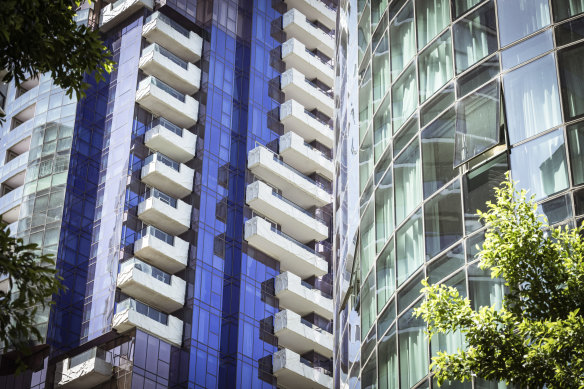This was published 3 months ago
Opinion
The great housing con is turning Melbourne into an Asian-style megacity
By Michael Buxton and David Hayward
Melbourne has changed greatly over the past 70 years, but now the state government plans to obliterate the city we know and value. The government has embarked on a quarter-century-long project to demolish much of the existing urban area and build a new city of high and medium-rise apartments.
This is a city-rebuilding model familiar in Asian, particularly Chinese, megacities, though few modern Western cities have adopted it.

Apartment buildings in Melbourne’s Docklands precinct.Credit: Chris Hopkins
The government has embraced the autocratic elements of this model, while imposing Australia’s most radical land-use planning deregulation to empower the development industry.
New planning rules will enable construction of high-rise towers in major activity centres and medium-rise apartments across vast residential areas, including those protected by heritage controls. They allow developers to override the planning system by directly approaching the government and excluding councils, and leave residents without rights of notification, objection and appeal.
This is an assault on locals who call these areas home, and is at odds with long-established democratic traditions.
All this is justified by a false narrative about a housing crisis caused by selfish residents who pressure local councils to prevent new housing. The government argues that removing planning controls is the only way to increase housing supply and lower prices.
Every element of this narrative is false. Housing approvals have consistently exceeded dwelling demand. Councils have approved a record number of homes; developers have not built them. Over the past year, 18,156 apartments and townhouses were approved in Victoria but not started, compared with 20,712 commenced.
The government should ensure that developers build on sites already released instead of proposing unrealistic new housing targets. Recent falls in construction have been caused primarily by development industry problems such as labour shortages, high materials costs and supply chain problems. High interest rates and a post-pandemic surge in migration have added to pressures on housing supply.
There is no “missing middle” of housing supply. Massive redevelopment has already occurred in the 13 middle-ring suburbs generally extending between five and 15 kilometres from the CBD. In the 30 years to 2021, 318,000 homes were built in Melbourne’s 15 main inner and middle-ring municipalities, increasing their housing by 55 per cent. About 90 per cent of this was medium and higher-density housing. If achieved, the government’s new housing targets would reduce the proportion of detached housing there to under 33 per cent.
The government is attempting to dupe citizens about the real causes and nature of the housing crisis, and to swindle residents out of their city. The blitz against traditional land use planning would obliterate the remnants of a once-Marvellous Melbourne.
Melburnians are already grappling with the long-term legacy of former state governments that have allowed developers free rein. The flammable cladding crisis is the latest example, at a cost to taxpayers of $600 million. Developers were left to their own devices in Docklands, and look how that turned out.
The loss of council oversight of building standards to the private sector illustrates the dangers of further deregulating the planning system. Building deregulation has resulted in decades of substandard apartments, leaving residents with the cost of remedying shameless building shortcuts, with water damage high on a long list.
The new housing targets propose 2 million additional homes in Melbourne by 2051, almost doubling the existing supply. The middle-ring suburbs would continue to bear most of the burden of new construction at 740,000 new dwellings or 37 per cent of the total, compared with 610,000 in the new outer growth corridors.
While some middle-ring suburbs are relatively well served by public transport, most are not. Most additional housing will be car-dependent, adding enormously to already high congestion levels and making movement in these suburbs increasingly difficult.
The Suburban Rail Loop will benefit relatively few of the 2 million projected new households but consume the bulk of available new public transport funds. The six SRL East precincts for stage 1, for example, will house only 70,000 new homes of the 241,000 earmarked for the four main municipalities the line will serve. In addition, the project will offer nothing to existing residents along its route because of the long distances between stations.
None of this makes sense.
Neither is it necessary. For decades, councils have been approving more than sufficient housing to meet demand. No evidence has been produced to show that Melbourne will experience the massive housing shortage assumed by the government’s targets and justifying the demolition of much of the existing city.
The government should press the pause button. Given the sheer scale of the proposed changes and the permanent damage that could be done, it is essential that the government allow residents and councils to contribute to decisions about what can be built where. Only a process of genuine participation of this kind will lead to housing needs being met without sacrificing the amenity and heritage values of our internationally acclaimed city.
We have inherited a city to be proud of. In the end, we inhabit the city we deserve.
Michael Buxton and David Hayward hold emeritus professor positions at RMIT University.
The Opinion newsletter is a weekly wrap of views that will challenge, champion and inform your own. Sign up here.